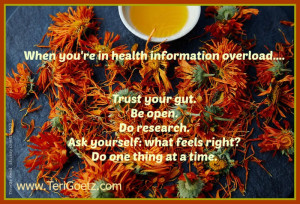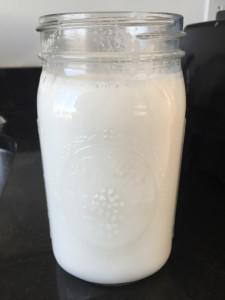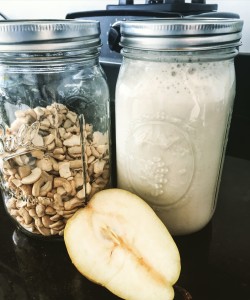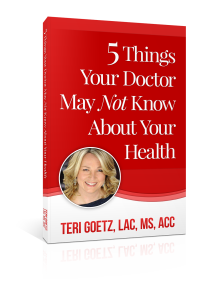 I’ve done it. Have you? A quick Google search about a symptom that has been bothering you or a recent diagnosis. Before you know it, the info is flooding your computer screen and you have more windows open than you can read in one day.
I’ve done it. Have you? A quick Google search about a symptom that has been bothering you or a recent diagnosis. Before you know it, the info is flooding your computer screen and you have more windows open than you can read in one day.
Which one has the “right” information? Whose advice do you take? Medicine?
Cleanses? Herbal support? Maybe you just have to eat more pineapple? How can you tell?
What do you do? Short of walking away from the computer and deciding you’re fine as you are, there are other options.
It is true: there is a lot to digest out there. But there is so much amazing research and so many new discoveries on various topics from the microbiome to brain plasticity that you don’t want to throw out the baby with the bathwater! But how do you decide what to listen to without getting confused?
Let me offer a few guidelines on finding some clarity amidst the info-overload. These are guidelines (not rules) because two of my core principles are that
1. we all have the capacity to heal way beyond what we think, and…
2. we need to empower ourselves and make our own healthcare decisions (with sound advice)
8 Guidelines to Handling Health Information Overload:
#1: Get quiet and listen to your inner knowing.
Use that inner knowing to help you pick one or two people whose work you really respect, and listen to their advice. That doesn’t mean be a blind follower and stop your research, it just means don’t try to do everything at once. And, importantly, follow your gut. You know more than you think you do.
I have patients who have seen a chiropractor, physical therapist, colon therapist, nutritionist, energy worker, and medical doctor. They’ve gotten conflicting advice from all of them. All they have as a result—in addition to 40 supplement bottles and a few prescriptions—is confusion. My advice when this happens? Don’t try everything at once. One at a time, and see what works for you.
#2: Test your reactions.
Our bodies are pretty wise caretakers of our souls. They give us hints about what is working and what’s not. If someone suggests you try L Glutamine for leaky gut (something I advise a lot of my patients to do) and you feel worse, then stop taking it. There is a small percentage of people in the world who can’t metabolize L glutamine well. They’ll know it because they’ll feel it.
#3: Realize there is no magic bullet.
We’ve become trained to think that when you take a medicine for a symptom and the symptom goes away, you have been cured. Like magic! Most times, this is the farthest thing from the truth. Take proton pump inhibitors like Prilosec™. Sure, your heartburn disappears, but are you cured? No! The medication eliminates your body’s hydrochloric acid production. You need that stuff! It helps you break down food and kills fungus and bacteria. This brings me to the next guideline….
#4: Take your health into your own hands.
Yes, it’s fine to do research. Keep doing research. Take the information you find to your healthcare practitioners and ask about it. Know that ultimately you will decide what makes sense to you—for your body, lifestyle, and inner knowing. And…
#5: Watch out for your own resistance to change.
Sometimes we don’t want to change anything because it will be too difficult. We don’t want to give up what’s making us feel sick (wine, cheese, gluten, etc.) and we make excuses. Sometimes you just don’t know it will work until you try it, so, on to the next guideline:
#6: Be smart, but give it a try.
Don’t try every new thing that comes down the pike! But if it’s something you’re reading or hearing a lot about and people are getting results, it might be worth a shot. Again, check in with healthcare practitioners whom you trust, and with yourself, and see if it’s right for you. And therefore, take heed of the next guideline…
#7: Be observant, not obsessive.
It’s easy to worry about everything that enters your mouth or touches your skin—especially with things like dietary changes that you must adhere to pretty strictly. Yes, some people have to be extra cautious—like with celiac or other food sensitivities. But, there is a balance somewhere between crazy-making behavior and common sense. If you have an autoimmune disease, for example, you do have to be very cautious… but don’t let it rule your life. Give yourself time to think about other things besides your “disease.” This leads me to the following guideline:
#8: Focus on what’s good and right in your life.
Focusing on your disease, label, diagnosis, is more likely to keep you sick. I decided early on that I wasn’t going to say I “had” Sjogren’s or Hashimoto’s disease. Instead, I say, “I was diagnosed with….” That helps me realize that much of the way I feel is up to me and my choices. It helps me lead a normal life where I am not defined by my disease.
Therefore there is a 9th guideline after all. Repeat after me: “I am not defined by my disease. A miracle can happen in any moment.” This is not fantasy thinking. Our minds directly affect our bodies (and vice versa) and negative thoughts have a physical impact. When you think you are your disease, it will color everything. You will lose sight of living fully. I know it can be hard when you are feeling lousy, but I urge to focus on what is beautiful and wonderful in your life. It will make all the difference in how you feel.
I hope you find these guidelines and perspectives helpful. It is so easy to get overwhelmed that we either shut down or try to do it all and get overwhelmed. Be mindful of how you are feeling. Live life like you mean it. Seek moderation and balance—watchwords for us all.

 Coconut and nut milks may be healthier alternatives to cow’s milk for many people, especially those following a paleo or elimination diet. For most adults, cutting down or cutting out dairy is a great idea. From a Chinese medicine perspective, dairy is basically phlegm! And, if you are like most Americans, your diet is already full of mucus producing, inflammatory foods.
Coconut and nut milks may be healthier alternatives to cow’s milk for many people, especially those following a paleo or elimination diet. For most adults, cutting down or cutting out dairy is a great idea. From a Chinese medicine perspective, dairy is basically phlegm! And, if you are like most Americans, your diet is already full of mucus producing, inflammatory foods.
